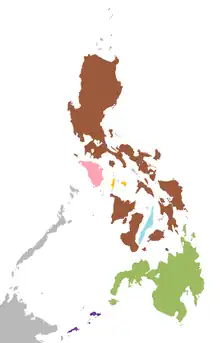Philippine hawk-owl
The Philippine hawk-owl is a species complex of owls in the family Strigidae. They are all endemic to the Philippines.
| Philippine hawk-owl | |
|---|---|
| Scientific classification | |
| Kingdom: | |
| Phylum: | |
| Class: | |
| Order: | |
| Family: | |
| Genus: | |
 | |
| Brown: Luzon Hawk Owl Ninox philippensis, including Ticao subspecies ticaoensis and Siquijor subspecies centralis
Green: Mindanao Hawk Owl N. spilocephala Pink: Mindoro Hawk Owl N. mindorensis Gold: Romblon Hawk Owl N. spilonota including Tablas subspecies fisheri Pale Blue: Cebu Hawk Owl N. rumseyi Dark Blue: Camiguin Hawk Owl N. leventisi Purple: Sulu Hawk Owl N. reyi | |
Description
The Philippine hawk-owls are earless. The males and females look much alike. They differ in size and pattern on the bottom side. N. reyi and N. spilonota are the biggest and N. philippensis, N. spilocephala and N. mindorensis the smallest. The pattern on the bottom side of N. reyi, N. p. spilonota and N. mindorensis is checked. The pattern on all the other species are striped.
Species range in size (including the tail) to a length of 21.0 to 26.5 cm and have a wingspan of 16.5 to 20.5 cm.
All are species splits from what was once recognized as a single species, N. philippensis, known together as the Philippine hawk-owl. Two of the owls have been recognized in 2012 as distinct species based on vocal and other differences. They were also previously characterized as subspecies.[1]
Systematics and taxonomy
There are seven known species:
- Luzon boobook, ''Ninox philippensis
- Mindoro boobook, Ninox mindorensis (Mindoro
- Sulu boobook, Ninox reyi (Bongao, Jolo, Sanga Sanga, Siasi, Sibutu and Tawi-Tawi)
- Mindanao boobook, Ninox spilocephala (Basilan, Dinagat, Mindanao and Siargao)
- Romblon boobook, Ninox spilonotus
- Cebu boobook, Ninox rumseyi (Cebu)
- Camiguin boobook, Ninox leventisi (Camiguin)
Locally, this bird is known as kuwago, like other large owls.
Ecology
The Philippine hawk-owl species can be found in forest areas up to an altitude of 1800 metres, although they mostly reside in areas less than 1000 metres above sea level. Natural habitats are subtropical or tropical moist lowland forest and subtropical or tropical moist montane forest. All of the species mate around February. The nests can be found in hollow trees.
References
- Kennedy, R.S., Gonzales P.C., Dickinson E.C., Miranda, Jr, H.C., Fisher T.H. (2000) A Guide to the Birds of the Philippines, Oxford University Press, Oxford.